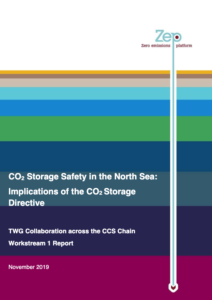- CO2 underground storage is a safe and mature technology ready for broad implementation, as evidenced by over twenty years of successful storage offshore in Norway, combined with more recent onshore storage in Canada and the USA. In Europe, CCS benefits from a clear set of regulations and requirements under the 2009 EU CO2 Storage Directive that ensure the identification of appropriate storage sites and the safety of subsequent operation.
- CCS is required for rapid and large-scale decarbonisation of major point sources. CCS provides robustness to decarbonisation strategies, especially for industrial clusters, and enables a just transition for industrial communities. CO2 transport and storage is required for a large variety of emissions sources, tackling process emissions and addressing the concept of ‘unavoidable emissions’ that would otherwise continue to be emitted to the atmosphere.
- For climate stabilisation, CO2 must be captured and permanently prevented from reaching the atmosphere. For a typical offshore North Sea storage site, the report concludes that both the likelihood and the potential volumes of released CO2 in a theoretic incident are very low and decrease with time. It can be expected that 99.99% of the injected CO2 remains in the subsurface. In the extremely unlikely event of a small CO2 leak, this will have a minor localised influence on the marine environment, as these ecosystems are naturally resilient to minor fluctuations in CO2 concentrations. With adequate remediation, even an extremely unlikely major leakage event will have a limited and temporary and local effect on marine ecosystems in a range limited to the km scale. The minor risks to the local marine environment presented by CO2 storage have to be balanced against the serious impacts that climate change and related ocean acidification are having today on the marine environment. These negative impacts will continue to escalate unless large-scale, rapid CO2 mitigation – including through the largescale deployment of CCS – is implemented.
- Since 2009/10, fewer CCS projects have been implemented than envisaged. This has largely been due to a number of factors such as the lack of a business case. Furthermore, concerns over the financial liabilities for CO2 storage development and the lack of clarity over how regulatory authorities will implement these measures have limited industry interest in applying for storage permits in a number of countries. Under the EU CO2 Storage Directive (and as interpreted under Guidance Document 4), operators of a CO2 storage facility are required to provide significant financial securities prior to operations to cover normal decommissioning obligations and ongoing monitoring operations. However, the Directive also requires taking account of extremely low probability incidents and there is a risk that licensing authorities would include the full impact of these incidents without taking probability into account. The consequent financial burden such combined securities add to each individual project undermines project
- Involved parties should develop and agree on a Monitoring, Measuring and Verification (MMV) program that is fit for purpose for the identified risks (addressing both impact and probability). Clarification and recognition of the difference between monitoring requirements for various types of storage sites in Guidance Document 4 is required, e.g. techniques for pre- and post- closure of storage in pressure depleted structures compared to aquifers are different. Moreover, a clear split between the essential elements of the Financial Security (decommissioning obligations, conformance monitoring) and extremely unlikely elements (leakage, non-conformance monitoring), would help the industry to accelerate deployment without undermining monitoring and safety mechanisms. The former should be detailed and required under each storage permit. The latter could be arranged on a country or sectoral basis where the competent authority would make arrangements with the industry to set aside a fund to cover such unlikely events.
- Getting initial CO2 transport and storage infrastructure built in Europe is critical to generate economies of scale that deliver major cost savings, support industrial decarbonisation and encourage innovation through R&D and the deployment of new technologies. As with other technologies, the costs of undertaking CO2 storage operations and monitoring will be further reduced with growing market for CO2 storage and greater competition for services and technology providers.

